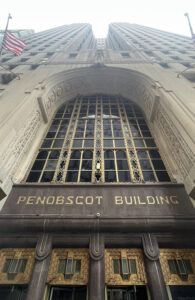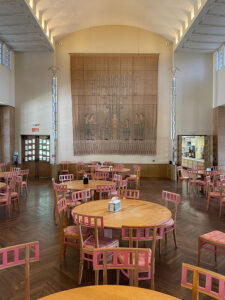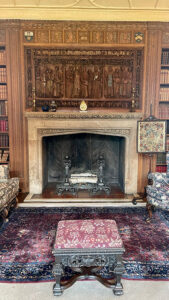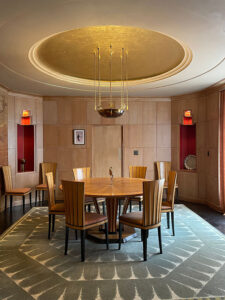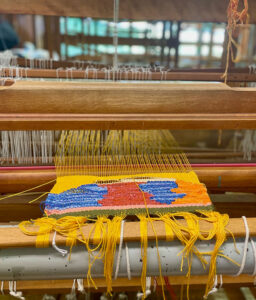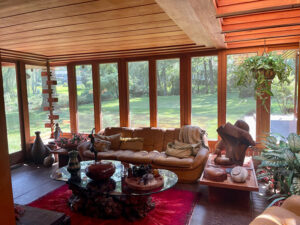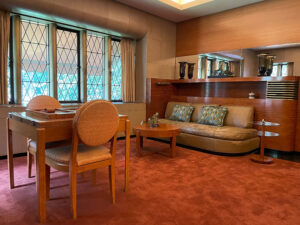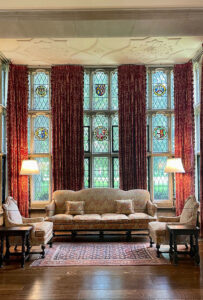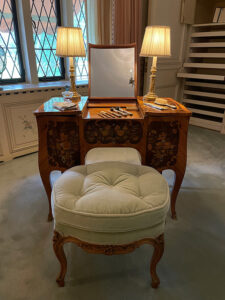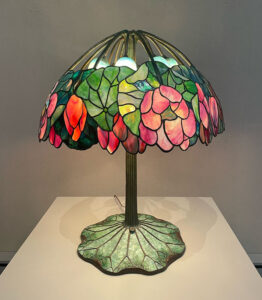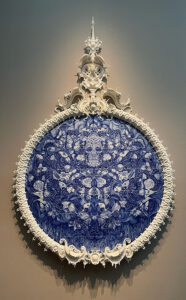Detroit and Cranbrook: Modernism and Historicism
EVENTS > SOJOURNS
SOJOURN
July 26–30, 2023
With an optional extension to the Toledo Museum of Art
July 30, 2023
Throughout the first half the 20th-century, the Motor City fostered competing historicist and modernist impulses. From grand Tudor Revival country houses to cutting edge building designs, important architectural projects sprang forth. This breadth of taste is also reflected in the collections of local museums and historic sites, which tell the story of the patronage that rendered Detroit one of the most important artistic centers of the era. From Bloomfield Hills to Grosse Pointe, and from the Detroit Institute of Arts to the Henry Ford Museum, join us for four days of visits to sites illustrating the Detroit area’s divergent interests in historicism and avant-gardism and the local passion for collecting across the cultural spectrum.
REGISTRATION NOW CLOSED
ITINERARY
Wednesday, July 26
Our base of operations for this Sojourn is Detroit’s Foundation Hotel, housed in Hans Gehrke’s 1929 Detroit Fire Department Headquarters with a red brick and terracotta facade over a steel frame. Gathering in the afternoon, we depart for an orientation walking tour of key buildings in the downtown area led by Kevin Adkisson, curator of the Cranbrook Center for Education and Research. Between 1910 and 1920, Detroit’s population more than doubled to reach 1,000,000, rapid growth fueled by the rise of the automobile industry. The city’s fortunes increased exponentially, resulting in a period of grand urban development.
The landmark Guardian Building was finished in 1929 and is a stunning Art Deco skyscraper. Commissioned by the Union Trust Co., architect Wirt C. Rowland of Smith, Hinchman & Grylls spared no detail throughout the 36-story structure. The exterior blends brickwork with tile, limestone, and terra cotta. The building’s three-story, vaulted lobby is lavishly decorated with Pewabic and Rookwood tile.
Of identical vintage, the Penobscot Building extends to 47 stories and was the fourth highest building in the United States when completed. This Art Deco skyscraper and two earlier Penobscot structures were developed for the Murphy family, who had roots along the Penobscot River in Maine and made their fortune in the 19th century in Michigan’s lumber trade. The building’s lower floors feature the work of master sculptor Corrado Parducci, who, in a tribute to Maine, created a river-like motif with logs floating down stream.
Our tour concludes at the Monarch Club, located on the rooftop of the Gothic Revival Metropolitan Building (1924), where we enjoy libations and a birds-eye view of the cityscape below. The chevron-shaped building was designed by the Detroit firm of Weston & Ellington, with space leased exclusively to jewelers and milliners operating in the wholesale and retail trades.
Following a chance to freshen up back at the Foundation, we reconvene for an introductory lecture by Kevin Adkisson on the city’s 20th-century architectural and cultural history as well as a wonderful kickoff dinner.
Included: R, D
Thursday, July 27
We are fortunate to secure a full-access day-long exploration at Cranbrook in Bloomfield Hills and the sublime resources stewarded by the Cranbrook Center for Collections and Research. Our trio of hosts includes Gregory Wittkopp, the Center’s Director; Kevin Adkisson; and Nina Blomfield, the Center’s Decorative Arts Trust-Marie Zimmermann Collections Fellow.
The root of this mecca of modernity is Cranbrook House, built in 1908 for Cranbrook’s founders, George Gough Booth and Ellen Scripps Booth, and their family. The English Arts and Crafts home was designed by famed Detroit architect Albert Kahn on a 100-acre farm that the Booths purchased in 1904. We admire the handcrafted tapestries, furniture, and wood carvings that the Booths commissioned for the house, and the art that they collected.
Saarinen House is Eliel Saarinen’s Art Deco masterwork and the jewel of Cranbrook’s architectural treasures. Designed in the late 1920s, Saarinen House served from 1930 through 1950 as the home and studio of the Finnish-American designer Eliel Saarinen—Cranbrook’s first resident architect and the Art Academy’s first president and the head of the Architecture Department—and Loja Saarinen—the Academy’s first head of the Weaving Department and director of Studio Loja Saarinen. The extraordinary interior, now impeccably restored, features the family’s original furnishings, including Eliel’s delicately veneered furniture and Loja’s sumptuous textiles, as well as elements designed by their daughter, Pipsan, and son, Eero.
The elder Saarinen choreographed much of the development that now constitutes the Cranbrook Educational Community, including the Academy of Art and Cranbrook Museum of Art, and Cranbrook School Dining Hall, where we enjoy lunch while seated on chairs that he designed.
The Booth family commissioned Oscar Murray for Bertram Goodhue and Associates to design Christ Church Cranbrook in the late 1920s. Considered one of the most significant Arts and Crafts ecclesiastical structures in America, its treasures include the largest tapestries ever woven by Morris & Co.’s Merton Abbey Works. Several contemporary artists contributed to the interiors, including Katherine McEwen, who painted the fresco, and Mary Chase Stratton, who created the ceiling of the Baptistry.
Our day concludes at the Frank Lloyd Wright-designed Smith House, where Nina shares her research on its rich holdings of 20th-century decorative arts. School teachers Sara Stein Smith and Melvyn Maxwell Smith met Wright at Taliesin in 1941 and commissioned an excellent example of his Usonian ideal, which aimed to build quality houses for the American middle class. We admire the beautiful range of objects acquired by the Smiths while enjoying a reception and toasting Nina’s contributions to Cranbrook.
Included: L, R
Friday, July 28
Our day opens at the Detroit Institute of Arts, a monument to artistic excellence designed by Philadelphia architect Paul Philippe Cret. The museum opened in 1927 and was “dedicated by the people of Detroit to the knowledge and enjoyment of art.” We are welcomed by Benjamin Colman, Associate Curator of American Art, and Chassicka Kirchoff, Assistant Curator of European Sculpture and Decorative Arts, for fulsome tours of their splendid collections, which were fueled by the community of collectors that developed in early-20th-century Detroit. We also pay tribute to Diego Rivera’s incredible Detroit Industry Murals (1932–33).
Following lunch at Chartreuse, housed in the landmark Park Shelton Building (1926), we head to Dearborn and the Henry Ford Museum of Innovation. Charles Sable, Curator of Decorative Arts, and Katherine White, Associate Curator of Modern Design, introduce the museum’s incredible holdings, which range from Colonial-era furniture and ceramics to Mathematica: A World of Numbers… and Beyond, a kinetic and static exhibition of mathematical concepts designed by Charles and Ray Eames that originally debuted at the California Museum of Science and Industry in 1961. Offering a bit of free time at the close of our visit, guests can enjoy additional exhibitions or a stroll through Greenfield Village.
Upon returning to Detroit, we are welcomed to Lafayette Park, a post-World War II development project led by Mies Van der Rohe that mixed low- and high-density housing, where Benjamin Colman hosts the group for a casual reception.
Included: L, R
Saturday, July 29
A lasting embodiment of Detroit’s contributions to the Arts and Crafts Movement, Pewabic Pottery opened in 1903 and continues to produce sought-after ceramics. Started by artist and teacher Mary Chase Perry Stratton, the pottery remains in a 1907 Tudor Revival building designed by her husband, William Buck Stratton. Steve McBride, Executive Director, provides a comprehensive introduction to the facility, which contains a working studio and museum.
We continue to the Grosse Pointes, which became a preferred suburb in the first decades of the 20th century for wealthy Detroiters, who purchased farms overlooking Lake St. Clair. Edsel and Eleanor Ford House stands as the pinnacle of this era of development. Greeted by Lisa Worley, Director of Material Culture, we enjoy another Albert Kahn-designed residential project influenced by English architectural antecedents. Envisioned as a true country house retreat, Kahn incorporated historic woodwork purchased in Britain. The extensive gardens were designed by Jens Jensen.
As part of our time in Grosse Pointe and the surrounding communities, we enjoy the opportunity to visit two private residences that testify to the impressive architectural projects developed in this area in the first half of the 20th century.
Returning to Detroit, we gather for a festive closing dinner at the historic and highly regarded London Chop House. This restaurant was established in 1938, providing an ideal backdrop for our celebration of four days of study and discovery.
Included: L, D
Optional extension: The Toledo Museum of Art
Sunday, July 30
Located just across the Ohio state line, Toledo’s early-20th-century development preceded that of Detroit and generated an impressive encyclopedic art institution in the Toledo Museum of Art. The museum was founded by Toledo glassmaker Edward Drummond Libbey in 1901, and moved to its current location, a Greek revival building designed by Edward B. Green and Harry W. Wachter, in 1912. Andrea Gardner, Senior Director of Collections and Curatorial Affairs, and Erin Corrales-Diaz, Curator of American Art, have organized a full-access visit to the museum, including an extensive exploration of the world-renowned glass collection. At the halfway point of our visit, we share lunch in the midst of the museum’s Glass Pavilion.
N.B. Participants will be dropped off at the Detroit airport in time for early evening flights.
Included: L
TERMS AND CONDITIONS
Registration fee: $2,900 per person, which includes hotel accommodations, plus all lectures, tours, meals, receptions, and transportation referenced above. Participants may elect to make an additional donation to the Trust’s Emerging Scholars Program through registration.
Optional programs: The Post-Sojourn Optional Tour is $300 per person.
Single supplement: The single supplement is $580.
Membership: All participants must be members of the Decorative Arts Trust. Visit decorativeartstrust.org/join for membership levels and benefits.
Cancelations and refunds: All cancelations received by April 26, 2023, are subject to a full refund less a $100 administrative fee per person. Participants canceling between April 26 and June 26, 2023, will receive a 50% refund. Refunds will not be made after June 26, 2023.
Itinerary: The schedule, sites, and events outlined in this itinerary are subject to change as necessary.
Participation: The program is limited to a maximum of 25 participants and requires a minimum of 15. We will organize and maintain waiting lists on the basis of the time registrations are received. Participants should be prepared to take a COVID test the day the tour begins and to wear masks when requested by our hosts.


